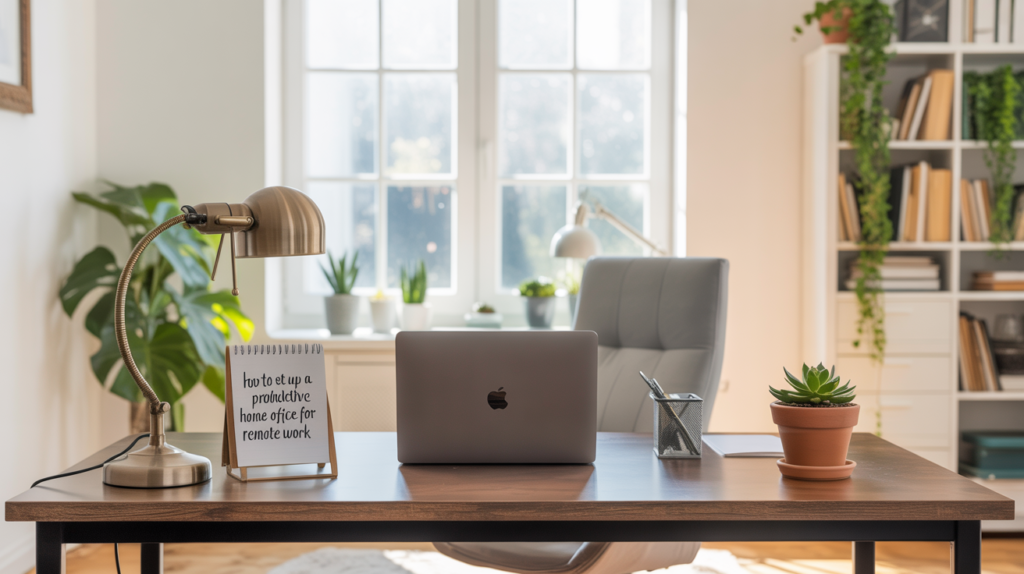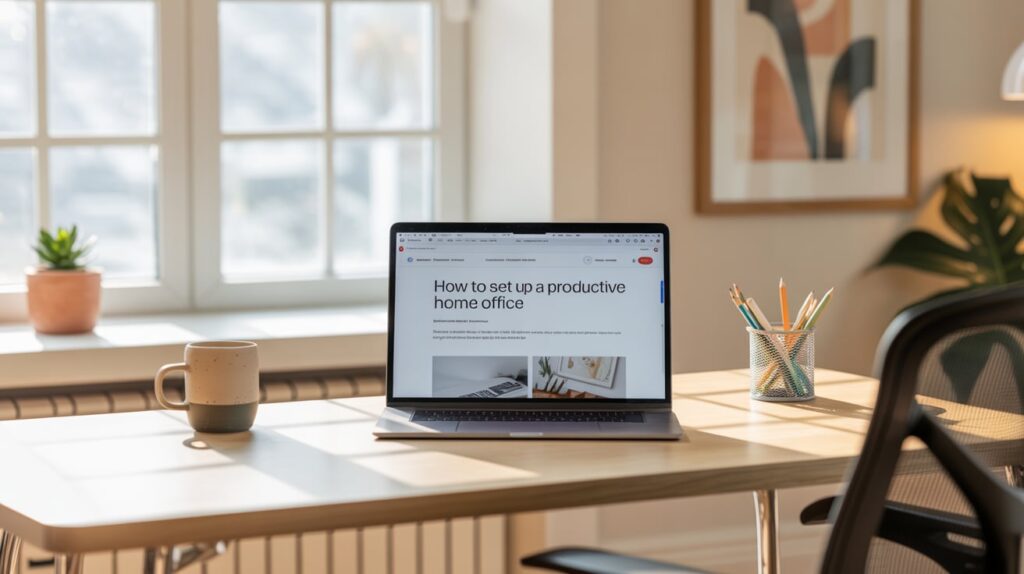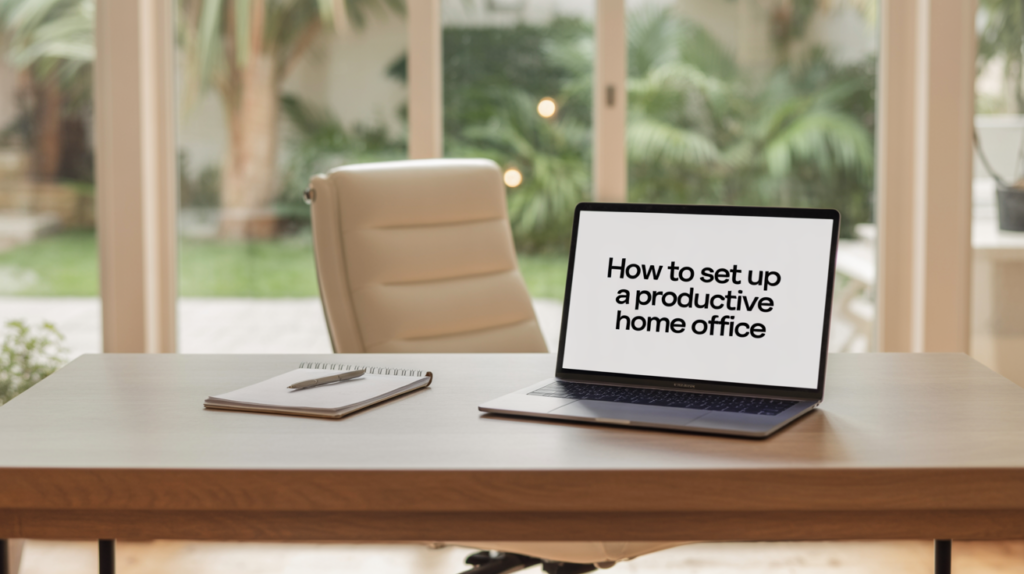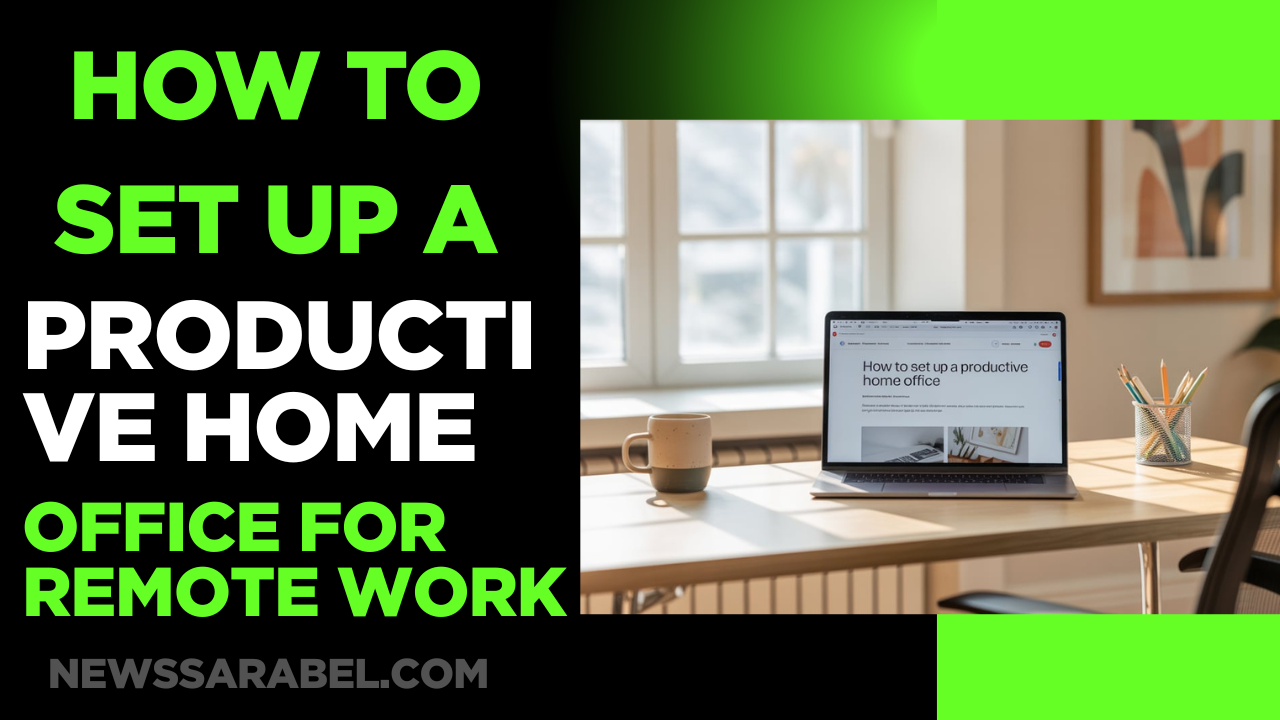Do you find it hard to stay focused while working from home? You’re not alone. Many people struggle to create a space that helps them work better and keeps distractions away.
Having a productive home office is key to balancing work and personal life. A good workspace helps you stay on track, avoid putting things off, and improve your productivity.

With the right setup and home office tips, you can turn your space into a productive area. Let’s look at the important parts of making a productive home workspace.
Key Takeaways
- Create a dedicated workspace to minimize distractions
- Invest in ergonomic furniture for comfort and productivity
- Implement effective time management strategies
- Minimize digital distractions with the right tools
- Establish a routine to maintain a healthy work-life balance
The Foundations of an Effective Remote Workspace
To have a productive home office, start by checking out your space and figuring out what you need for work. To organize your home office efficiently, first see how much space you have. Then, think about how you can make it work best for remote work office essentials.
Assessing Your Available Space Options
When looking at your space, think about how you can change it for work.
Identifying Underutilized Areas in Your Home
Look for spots that are rarely used, like a corner of a room or an unused attic. These can be turned into a useful workspace.
Considering Temporary vs. Permanent Solutions
Decide if you need a temporary setup or a permanent home office. This choice will affect what furniture and equipment you pick.
Defining Your Work Requirements
It’s important to know your daily tasks and needs. This helps you create a workspace that fits your work style.
Analyzing Your Daily Tasks and Needs
Write down your daily tasks and what tools you use. This will help you figure out the essential equipment for your remote work office.
Planning for Future Growth
Think about your future needs and how your work might change. Planning keeps your workspace useful.

How to Set Up a Home Office for Remote Work: Location Considerations
Choosing the right spot for your home office is key for comfort and productivity. The location greatly affects your ergonomic home office design and remote work productivity hacks.
Selecting a Dedicated Work Area
When setting up a virtual office, pick a specific spot for work. This area should only be for work to keep your work and personal life separate. Look for a quiet spot with little foot traffic.
Minimizing Distractions and Noise
Reducing distractions is crucial for remote work productivity hacks. Find a spot away from busy and noisy areas. Use noise-cancelling materials or apps to cut down on background noise.
Ensuring Privacy for Video Calls
For video calls, ensuring privacy is essential. Choose a spot where you can keep your calls private and avoid distractions. Use a backdrop or a dedicated studio for video calls to look professional.
By thinking about these location factors, you can make a home office that boosts your productivity and well-being.
Essential Furniture for Your Home Office Setup
Setting up a productive home office begins with the right furniture. The furniture you pick affects your comfort, productivity, and work experience. Think about your space size, work needs, and personal taste when choosing.
Selecting the Right Desk for Your Space
Your desk is the heart of your home office. It should fit your computer, papers, and other must-haves.
Standing Desk Options and Benefits
Standing desks let you switch between sitting and standing. This helps keep you healthy and reduces back pain.
Space-Saving Desk Solutions
For small offices, a wall-mounted desk or a compact corner desk can save space.
Investing in a Quality Ergonomic Chair
An ergonomic chair is key for good posture and less back and neck pain. Look for one with adjustable height, lumbar support, and breathable fabric.
Additional Furniture Pieces Worth Considering
Other furniture can make your home office better.
Storage Furniture for Office Supplies
Storage units like file cabinets and shelves keep your office tidy and organized.
Comfort Elements: Footrests and Keyboard Trays
Creating an Ergonomic Workspace at Home
Setting up an ergonomic workspace at home is key for your health and work efficiency. It prevents discomfort, injury, and long-term health problems. This way, you can work better and longer.
Proper Desk and Chair Height Adjustments
Start by adjusting your desk and chair to the right heights. Your chair should fit your lower back’s natural curve. The desk should let you work with elbows at 90 degrees and wrists straight.
Monitor Positioning and Eye Strain Prevention
Right monitor placement is key to avoid eye strain. Place your monitor about 20-25 inches away. It should be at a height where you look slightly down.
Multi-Monitor Setup Recommendations
If you have multiple monitors, set them at a 90-degree angle. This cuts down on eye movement.

Blue Light Filters and Screen Protectors
Use blue light filters or screen protectors. They help reduce eye strain from too much screen time.
Keyboard and Mouse Ergonomics
Make sure your keyboard is at a height that keeps your wrists straight. Your elbows should be at 90 degrees. Choose a mouse that feels good and is close to your body to avoid stretching.
| Ergonomic Element | Correct Setup | Benefits |
| Desk Height | Elbows at 90 degrees, wrists straight | Reduces strain on shoulders and wrists |
| Chair Height | Feet flat on floor or on a footrest, knees at or below hip level | Promotes good posture and reduces back strain |
| Monitor Position | Directly in front, 20-25 inches away, gaze slightly downward | Reduces eye strain and promotes comfortable viewing |
Technology and Equipment Essentials for Remote Work
To work from home well, you need the right tech and gear. A good home office setup boosts your productivity and work efficiency.
Computer Setup Recommendations
Your computer is key to remote work. Think about what you need and what you like when choosing between a laptop and desktop.
Laptop vs. Desktop Considerations
A laptop is great for moving around. It’s perfect if you work from different spots. A desktop gives you more power and a better setup for your body.
Essential Peripherals and Accessories
Whether you pick a laptop or desktop, you’ll need essential peripherals. This includes a monitor, keyboard, mouse, and headset. They make your workspace comfy and efficient.
Internet Connectivity Solutions
A good internet connection is key for working from home. You can pick between wired and wireless options.
Wired vs. Wireless Options
Wired connections are stable and safe. Wireless connections are flexible and easy to use. Think about your work space and needs when deciding.
Backup Internet Strategies
Having a backup internet strategy is smart. This could be a mobile hotspot. It helps keep you connected if your main internet goes down.
Video Conferencing Equipment
For video calls, you’ll need a camera, microphone, and speaker. Many all-in-one devices combine these features.
| Equipment | Considerations | Benefits |
| Laptop | Portability, flexibility | Ideal for working from different locations |
| Desktop | Power, ergonomic setup | Better for heavy-duty tasks and comfort |
| Wired Internet | Stability, security | Less prone to interference |
| Wireless Internet | Flexibility, convenience | Easier to set up and move around |
Organizing Your Home Office Efficiently
To work better from home, organizing your office is key. A tidy space boosts your work and cuts down stress.
Storage Solutions for Limited Space
With little room, smart storage is vital. Think about vertical shelving units or compact filing cabinets. They help keep important papers handy and your desk clear.
Cable Management Strategies
Keeping cables tidy is important for safety and lappearance Use cable organizers or cable ties to manage cords. This stops tripping and makes your area look better.
Digital Organization Systems
Organizing your digital space is as crucial as your physical one. Digital tools can make you more productive.
File Management Best Practices
Use a simple naming system for files and folders. This makes finding documents easy. Also, back up your files with cloud services.
Productivity Apps and Tools
Apps for managing projects and tasks can help a lot. Tools like Trello or Asana make organizing work easier.
| Organization Aspect | Physical/Digital | Tools/Strategies |
| Storage | Physical | Shelving units, Filing cabinets |
| Cable Management | Physical | Cable organizers, Cable ties |
| File Management | Digital | Cloud storage, Clear naming conventions |
| Productivity | Digital | Trello, Asana |
Optimizing Your Home Office Environment
A well-optimized home office can boost your productivity and happiness. To make your workspace great, focus on a few key areas. These will help you work better and feel better, too.
Lighting Considerations for Productivity
Good lighting is key to avoiding eye strain and staying focused. The right lighting can make a big difference in your work area.
Natural vs. Artificial Light Sources
Natural light is the best, but it’s not always available. Use high-quality artificial lights that feel like natural light. LED bulbs are a smart choice because they save energy and don’t get too hot.
Task Lighting Placement
Place task lighting to avoid glare on your screen and light up your work area well. This helps prevent eye strain and boosts your productivity.
Temperature and Air Quality Control
Keeping your office at a comfy temperature and air quality is important for your health and work. Make sure your office is well-ventilated and at a good temperature.
Incorporating Plants and Personal Touches
Adding plants and personal touches can make your office feel more welcoming and productive.
Biophilic Design Elements
Adding elements of nature, like plants or a water feature, can make your space calm. This is called biophilic design.
Personalizing Without Cluttering
Make your space your own with things that inspire you, but don’t let it get cluttered. A good balance of personal touches can improve your work area without distracting you.
| Aspect | Considerations | Benefits |
| Lighting | Natural vs. Artificial, Task Lighting | Reduces eye strain, improves focus |
| Temperature and Air Quality | Ventilation, Comfortable Temperature | Enhances health and productivity |
| Personal Touches | Plants, Biophilic Design, Minimal Clutter | Creates a welcoming and productive environment |
Conclusion: Maintaining Your Productive Home Office
Creating a productive home office is just the first step. Keeping it up is key for lasting success in remote work. By using the tips for setting up your home office, you can make your work area better and work more efficiently.
To keep your home office productive, check your workspace often. Make sure it still fits your needs. Use remote work hacks like avoiding distractions and keeping your space ergonomic to stay focused and avoid burnout.
Your home office should show your work style and needs. By using the strategies mentioned, you can make a space that boosts productivity and helps your career. Spend time keeping your home office in top shape. You’ll see better work results and be happier at your job.
Follow these tips and keep improving your workspace. This way, you can have a productive home office that meets your remote work needs.
FAQ
What are the most important factors to consider when setting up a home office for remote work?
Key factors include a dedicated space, few distractions, and ergonomic furniture. Also, reliable technology is crucial for productivity and comfort.
How can I create a productive workspace at home?
Start by identifying your work needs. Choose a dedicated area and invest in good furniture and tech. A comfy chair and a reliable computer are must-haves.
What are some tips for organizing my home office efficiently?
Use storage and cable management to keep things tidy. Digital tools like file management and productivity apps also help.
How can I optimize my home office environment for productivity?
Think about lighting, temperature, and air quality. Add plants and personal touches to make your space inspiring and comfortable.
What are the benefits of using an ergonomic chair and desk?
Ergonomic furniture prevents discomfort and injury. It improves posture and boosts productivity, making it vital for remote workers.
How can I minimize distractions and noise in my home office?
Choose a quiet area and use noise-cancelling headphones. Soundproofing or working during quiet hours can also help.
What are the essential technologies and equipment for remote work?
You’ll need a reliable computer, stable internet, and video conferencing tools. Don’t forget peripherals like a headset and microphone.
How can I ensure privacy for video calls in my home office?
Pick a quiet spot with minimal distractions. Use headphones and invest in a quality webcam and microphone for privacy.
What are some best practices for maintaining a productive home office?
Stick to a routine and set boundaries. Regularly declutter and organize to keep your space efficient and comfortable.
